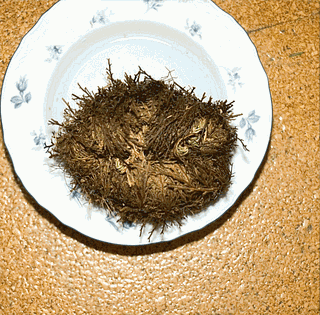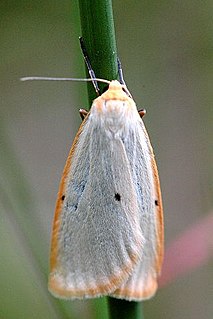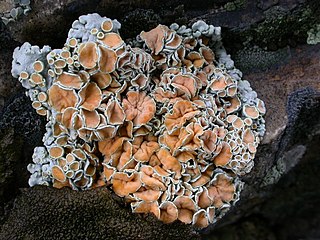Dot lichen is a common name for lichens in the genus Arthonia or genus Micarea . "Dotted lichens" are lichens in the genus Bacidia .
| | This article about lichens or lichenology is a stub. You can help Wikipedia by expanding it. |
Dot lichen is a common name for lichens in the genus Arthonia or genus Micarea . "Dotted lichens" are lichens in the genus Bacidia .
| | This article about lichens or lichenology is a stub. You can help Wikipedia by expanding it. |

Quail is a collective name for several genera of mid-sized birds generally placed in the order Galliformes.

A raven is one of several larger-bodied species of the genus Corvus. These species do not form a single taxonomic group within the genus.
Redfish is a common name for several species of fish. It is most commonly applied to certain deep-sea rockfish in the genus Sebastes, or the reef dwelling snappers in the genus Lutjanus. It is also applied to the slimeheads or roughies, and the alfonsinos (Berycidae).

A lichen is a composite organism that arises from algae or cyanobacteria living among filaments of multiple fungi species in a mutualistic relationship. Lichens have properties different from those of their component organisms. Lichens come in many colors, sizes, and forms and are sometimes plant-like, but lichens are not plants. Lichens may have tiny, leafless branches (fruticose), flat leaf-like structures (foliose), flakes that lie on the surface like peeling paint (crustose), a powder-like appearance (leprose), or other growth forms.
Rockfish is a common term for several species of fish, referring to their tendency to hide among rocks.
Bluefin tuna is a common name used to refer to several species of tuna of the genus Thunnus.
Old man's beard may refer to the following species:
A basilisk is a legendary reptile reputed to be king of serpents.
Parmelia may refer to:

Rock tripe is the common name for various lichens of the genus Umbilicaria that grow on rocks. They can be found throughout northern parts of North America such as New England and the Rocky Mountains. They are edible when properly prepared and have been used as a famine food in extreme cases when other food sources were unavailable, as by early American northern explorers.

A resurrection plant is any poikilohydric plant that can survive extreme dehydration, even over months or years.
Tree moss is a common name for several organisms and may refer to:

Grackle is the common name of any of 11 passerine birds native to North and South America. They belong to various genera in the icterid family. In all the species with this name, adult males have black or mostly black plumage.
Bullfinch is a name given to two groups of passerine birds.

Cybosia is a monotypic moth genus in the subfamily Arctiinae erected by Jacob Hübner in 1819. Its only species, Cybosia mesomella, the four-dotted footman, was first described by Carl Linnaeus in his 1758 10th edition of Systema Naturae.
An ulcer is a discontinuity or break in a bodily membrane that impedes normal function of the affected organ. According to Robins's pathology, "ulcer is the breach of the continuity of skin, epithelium or mucous membrane caused by sloughing out of inflamed necrotic tissue." Common forms of ulcers recognized in medicine include:
Tania is a female given name

Rhizoplaca is a genus of lichenized fungi in the family Lecanoraceae. Members of the genus are commonly called rimmed navel lichens because of their umbillicate growth form and lecanorine apothecia, also rock-posy lichen and rockbright. The genus has a widespread distribution and contains 11 species.

Rhizocarpon is a genus of crustose, saxicolous, lecideoid lichens in the family Rhizocarpaceae. The genus is common in arctic-alpine environments, but also occurs throughout temperate, subtropical, and even tropical regions. They are commonly known as map lichens because of the prothallus forming border-like bands between colonies in some species, like the common map lichen.